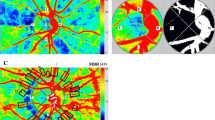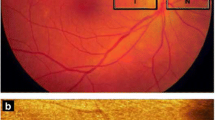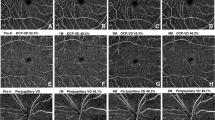Abstract
Purpose
Diabetic retinopathy is one of the leading causes of blindness in the Western world. The disease is characterized by morphological lesions secondary to disturbances in retinal blood flow assumed to be related to disturbances in retinal autoregulation. However, there is a need for elucidating the relation between disturbances in diameter regulation of retinal vessels and the development of diabetic retinopathy in longitudinal studies.
Methods
Sixty-four patients with type 2 diabetes mellitus were subjected to measurement of pressure autoregulation of retinal arterioles using the Dynamic Vessel Analyzer (DVA) and measurement of retinal thickness using OCT scanning, and after a mean of 6.8 years, 42 of the patients were re-examined. The vascular response was compared in patients in whom retinopathy had disappeared, was unchanged, or had worsened.
Results
At baseline, hemoglobin A1c (HbA1c) was significantly higher in the patients who would later experience worsening of diabetic retinopathy than in the other groups, but had been reduced at the follow-up examination. During the follow-up period, the resting diameter of retinal arterioles decreased significantly in the patients who experienced improvement in diabetic retinopathy but was unchanged in the other groups, whereas both the diameter response of retinal arterioles to isometric exercise and retinal thickness increased non-significantly with worsening of retinopathy.
Conclusions
The development of diabetic retinopathy is related to the diameter of retinal arterioles. Future clinical intervention studies should aim at investigating the effects of normalizing arteriolar diameters in diabetic retinopathy.




Similar content being viewed by others
References
Klein BE (2007) Overview of epidemiologic studies of diabetic retinopathy. Ophthalmic Epidemiol 14(4):179–183
Yau JW, Rogers SL, Kawasaki R et al (2012) Global prevalence and major risk factors of diabetic retinopathy. Diabetes Care 35(3):556–564
Ding J, Wong TY (2012) Current epidemiology of diabetic retinopathy and diabetic macular edema. Curr Diab Rep 12(4):346–354
Chen L, Magliano DJ, Zimmet PZ (2011) The worldwide epidemiology of type 2 diabetes mellitus—present and future perspectives. Nat Rev Endocrinol 8(4):228–236
Cheung N, Mitchell P, Wong TY (2010) Diabetic retinopathy. Lancet 376(9735):124–136
Pemp B, Schmetterer L (2008) Ocular blood flow in diabetes and age-related macular degeneration. Can J Ophthalmol 43(3):295–301
Kohner EM, Patel V, Rassam SM (1995) Role of blood flow and impaired autoregulation in the pathogenesis of diabetic retinopathy. Diabetes 44(6):603–607
Frederiksen CA, Jeppesen P, Knudsen ST, Poulsen PL, Mogensen CE, Bek T (2006) The blood pressure-induced diameter response of retinal arterioles decreases with increasing diabetic maculopathy. Graefes Arch Clin Exp Ophthalmol 244(10):1255–1261
Garhofer G, Bek T, Boehm AG et al (2010) Use of the retinal vessel analyzer in ocular blood flow research. Acta Ophthalmol 88(7):717–722
Fallon TJ, Maxwell DL, Kohner EM (1987) Autoregulation of retinal blood flow in diabetic retinopathy measured by the blue-light entoptic technique. Ophthalmology 94(11):1410–1415
Sinclair SH, Grunwald JE, Riva CE, Braunstein SN, Nichols CW, Schwartz SS (1982) Retinal vascular autoregulation in diabetes mellitus. Ophthalmology 89(7):748–750
Sieker HO, Hickam JB (1953) Normal and impaired retinal vascular reactivity. Circulation 7(1):79–83
Bentsen N, Larsen B, Lassen NA (1975) Chronically impaired autoregulation of cerebral blood flow in long-term diabetics. Stroke 6(5):497–502
Kim YS, Immink RV, Stok WJ, Karemaker JM, Secher NH, van Lieshout JJ (2008) Dynamic cerebral autoregulatory capacity is affected early in type 2 diabetes. Clin Sci (Lond) 115(8):255–262
Carmines PK (2010) The renal vascular response to diabetes. Curr Opin Nephrol Hypertens 19(1):85–90
Jeppesen P, Bek T (2006) Impaired retinal autoregulation in small retinal arterioles before and after focal laser treatment for diabetic maculopathy. Br J Ophthalmol 90(2):198–201
Bek T, Hajari J, Jeppesen P (2008) Interaction between flicker-induced vasodilatation and pressure autoregulation in early retinopathy of type 2 diabetes. Graefes Arch Clin Exp Ophthalmol 246(5):763–769
Skov Jensen P, Jeppesen P, Bek T (2011) Differential diameter responses in macular and peripheral retinal arterioles may contribute to the regional distribution of diabetic retinopathy lesions. Graefes Arch Clin Exp Ophthalmol 249(3):407–412
Ling R, Ramsewak V, Taylor D, Jacob J (2002) Longitudinal study of a cohort of people with diabetes screened by the Exeter Diabetic Retinopathy Screening Programme. Eye (Lond) 16(2):140–145
Gaede P, Lund-Andersen H, Parving HH, Pedersen O (2008) Effect of a multifactorial intervention on mortality in type 2 diabetes. N Engl J Med 358(6):580–591
Wong TY, Klein R, Klein BE, Meuer SM, Hubbard LD (2003) Retinal vessel diameters and their associations with age and blood pressure. Invest Ophthalmol Vis Sci 44(11):4644–4650
Leung H, Wang JJ, Rochtchina E, Tan AG, Wong TY, Klein R, Hubbard LD, Mitchell P (2003) Relationships between age, blood pressure, and retinal vessel diameters in an older population. Invest Ophthalmol Vis Sci 44(7):2900–2904
Tikellis G, Wang JJ, Tapp R, Simpson R, Mitchell P, Zimmet PZ, Shaw J, Wong TY (2007) The relationship of retinal vascular calibre to diabetes and retinopathy: The Australian Diabetes, Obesity and Lifestyle (AusDiab) Study. Diabetologia 50(11):2263–2271
Kifley A, Wang JJ, Cugati S, Wong TY, Mitchell P (2007) Retinal vascular caliber, diabetes, and retinopathy. Am J Ophthalmol 143(6):1024–1026
Alibrahim E, Donaghue KC, Rogers S, Hing S, Jenkins AJ, Chan A, Wong TY (2006) Retinal vascular caliber and risk of retinopathy in young patients with type 1 diabetes. Ophthalmology 113(9):1499–1503
Rogers SL, Tikellis G, Cheung N, Tapp R, Shaw J, Zimmet PZ, Mitchell P, Wang JJ, Wong TY (2008) Retinal arteriolar caliber predicts incident retinopathy: The Australian Diabetes, Obesity and Lifestyle (AusDiab) Study. Diabetes Care 31(4):761–763
Klein R, Klein BE, Moss SE, Wong TY (2007) Retinal vessel caliber and microvascular and macrovascular disease in type 2 diabetes: XXI: the Wisconsin Epidemiologic Study of Diabetic Retinopathy. Ophthalmology 114(10):1884–1892
Cheung N, Tikellis G, Wang JJ (2007) Diabetic retinopathy. Ophthalmology 114(11):2098–2099, author reply 2099
Klein R, Klein BE, Moss SE, Wong TY, Hubbard L, Cruickshanks KJ, Palta M (2004) The relation of retinal vessel caliber to the incidence and progression of diabetic retinopathy: XIX: the Wisconsin Epidemiologic Study of Diabetic Retinopathy. Arch Ophthalmol 122(1):76–83
Kristinsson JK, Gottfredsdottir MS, Stefansson E (1997) Retinal vessel dilatation and elongation precedes diabetic macular oedema. Br J Ophthalmol 81(4):274–278
Bek T (1999) Diabetic maculopathy caused by disturbances in retinal vasomotion. A new hypothesis. Acta Ophthalmol Scand 77(4):376–380
Gardiner TA, Archer DB, Curtis TM, Stitt AW (2007) Arteriolar involvement in the microvascular lesions of diabetic retinopathy: implications for pathogenesis. Microcirculation 14(1):25–38
Curtis TM, Gardiner TA, Stitt AW (2009) Microvascular lesions of diabetic retinopathy: clues towards understanding pathogenesis? Eye (Lond) 23(7):1496–1508
Jeppesen P, Gregersen PA, Bek T (2004) The age-dependent decrease in the myogenic response of retinal arterioles as studied with the retinal vessel analyzer. Graefes Arch Clin Exp Ophthalmol 242(11):914–919
Gottfredsdottir MS, Stefansson E, Jonasson F, Gislason I (1993) Retinal vasoconstriction after laser treatment for diabetic macular edema. Am J Ophthalmol 115(1):64–67
Tilma KK, Bek T (2012) Topical treatment for 1 week with latanoprost but not diclofenac reduces the diameter of dilated retinal arterioles in patients with type 1 diabetes mellitus and mild retinopathy. Acta Ophthalmol 90(8):750–755
Acknowledgments
This study was supported by the VELUX Foundation, which had no role in the design and conduct of the study; collection, management, analysis, or interpretation of the data; or preparation, review, or approval of the manuscript.
Conflict of interest
None.
Author information
Authors and Affiliations
Corresponding author
Additional information
The authors had full control of the primary data in the study and take responsibility for the integrity of the data and the accuracy of the data analysis.
Rights and permissions
About this article
Cite this article
Pedersen, L., Jeppesen, P., Knudsen, S.T. et al. Improvement of mild retinopathy in type 2 diabetic patients correlates with narrowing of retinal arterioles. A prospective observational study. Graefes Arch Clin Exp Ophthalmol 252, 1561–1567 (2014). https://doi.org/10.1007/s00417-014-2614-6
Received:
Revised:
Accepted:
Published:
Issue Date:
DOI: https://doi.org/10.1007/s00417-014-2614-6




